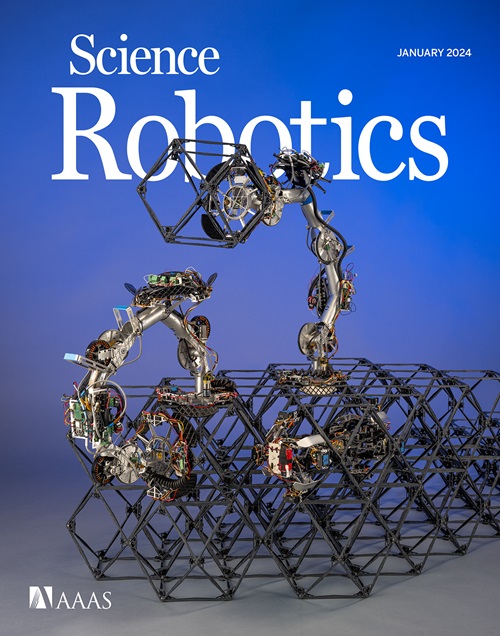Si chiplet–controlled 3D modular microrobots with smart communication in natural aqueous environments
IF 27.5
1区 计算机科学
Q1 ROBOTICS
引用次数: 0
Abstract
Modular microrobotics can potentially address many information-intensive microtasks in medicine, manufacturing, and the environment. However, surface area has limited the natural powering, communication, functional integration, and self-assembly of smart mass-fabricated modular robotic devices at small scales. We demonstrate the integrated self-folding and self-rolling of functionalized patterned interior and exterior membrane surfaces resulting in programmable, self-assembling, intercommunicating, and self-locomoting micromodules (smartlets ≤ 1 cubic millimeter) with interior chambers for onboard buoyancy control. The microrobotic divers, with 360° solar harvesting rolls, functioned with sufficient ambient power for communication and programmed locomotion in water via electrolysis. The interior folding faces carried rigid microcomponents, including silicon chiplets (Si chiplets) as microprocessors and micro–light-emitting diodes (LEDs) for communication. The exterior faces were able to engage in specific patterned docking interactions between smartlets. The heterogeneous integration is mass producible and affordable through two-dimensional (2D)–automated lithography and microchiplet bump-bonding processes, here shown to be compatible with subsequent autonomous 3D folding and rolling. The robotic modules functioned in natural aqueous environments, and the technology was analyzed as scalable down to microscopic dimensions. Selectively addressed communication with individual smartlets was enhanced via frequency-specific optical signals and enabled precise control, allowing each smartlet to be activated independently within a collective system. The work remodels modular microrobotics closer to the surface-rich modular autonomy of biological cells and provides an economical platform for microscopic applications.
自然水环境中具有智能通信功能的硅晶片控制的三维模块化微型机器人
模块化微型机器人可以潜在地解决医学、制造业和环境中的许多信息密集型微型任务。然而,在小尺度上,表面积限制了智能批量制造模块化机器人设备的自然动力、通信、功能集成和自组装。我们展示了功能化图型内外膜表面的集成自折叠和自滚动,从而形成可编程、自组装、相互通信和自移动的微模块(smartlets≤1立方毫米),其内部腔室用于板载浮力控制。微型潜水机器人配有360°太阳能收集卷,具有足够的环境电力进行通信,并通过电解在水中进行编程运动。内部折叠面携带刚性微组件,包括作为微处理器的硅晶片(Si chiplets)和用于通信的微型发光二极管(led)。外部表面能够在智能手机之间进行特定模式的对接交互。通过二维(2D)自动化光刻和微晶片碰撞键合工艺,异质集成是可批量生产的,并且价格合理,这里显示与随后的自主3D折叠和轧制兼容。机器人模块在自然水环境中发挥作用,该技术被分析为可扩展到微观尺度。通过特定频率的光学信号增强了与单个智能手机的选择性寻址通信,并实现了精确控制,允许每个智能手机在一个集体系统中独立激活。这项工作使模块化微型机器人更接近于生物细胞的表面丰富的模块化自治,并为微观应用提供了一个经济的平台。
本文章由计算机程序翻译,如有差异,请以英文原文为准。
求助全文
约1分钟内获得全文
求助全文
来源期刊

Science Robotics
Mathematics-Control and Optimization
CiteScore
30.60
自引率
2.80%
发文量
83
期刊介绍:
Science Robotics publishes original, peer-reviewed, science- or engineering-based research articles that advance the field of robotics. The journal also features editor-commissioned Reviews. An international team of academic editors holds Science Robotics articles to the same high-quality standard that is the hallmark of the Science family of journals.
Sub-topics include: actuators, advanced materials, artificial Intelligence, autonomous vehicles, bio-inspired design, exoskeletons, fabrication, field robotics, human-robot interaction, humanoids, industrial robotics, kinematics, machine learning, material science, medical technology, motion planning and control, micro- and nano-robotics, multi-robot control, sensors, service robotics, social and ethical issues, soft robotics, and space, planetary and undersea exploration.
 求助内容:
求助内容: 应助结果提醒方式:
应助结果提醒方式:


